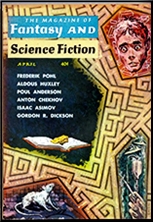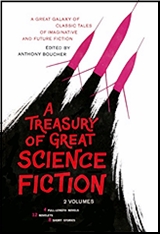Thu 7 May 2020
Locked Room PI SF Stories I’m Reading: POUL ANDERSON “The Martian Crown Jewels.â€
Posted by Steve under Science Fiction & Fantasy , Stories I'm Reading[11] Comments

POUL ANDERSON “The Martian Crown Jewels.†Short story. Freehatched Syaloch #1. First published in Ellery Queen’s Mystery Magazine, February 1958. Reprinted in The Magazine of Fantasy & Science Fiction, April 1959; in A Treasury of Great Science Fiction, Volume One, edited by Anthony Boucher (Doubleday, hardcover, 1959); and in (among others) Ellery Queen’s Murder – In Spades! (Pyramid, paperback, 1969) as “The Theft of the Martian Crown Jewels.†Collected in Call Me Joe: The Collected Short Works of Poul Anderson #1. (NESFA Press, hardcover, 2009).
If you are roughly the same age as I, and if you’ve read the story yourself, there’s a good chance that you did so in the two volume set of the Treasury edited by Anthony Boucher (see above) and given out as a premium to untold new members of the SF Book Club back the 1960s and for many years beyond. It’s also been reprinted many times; I didn’t begin to list them all.

One reason for the story’s popularity, I think, is that there really aren’t many examples of combining traditional detective stories with hardcore SF, and this is a good one. The detective on the case is Martian private detective Freehatched Syaloch, but this seems to have been his only appearance in print. Missing are the Martian crown jewels, which have been on display on Earth, but on their state secret return to Mars, via Phobos, one of the planet’s moons, they have completely disappeared.
The rocket they were on was unmanned. They were definitely loaded onto the ship on Earth, but once the ship landed on Phobos, they are nowhere to be seen. The chances of the ship having bee being boarded along the way in the vast expanses of space is impossible, but yet, they are nowhere on the ship, which is hastily taken apart, piece by piece, to be sure.
While he wrote a few out-and-out mysteries, Poul Anderson was far better known as the writer of hundreds of both fantasy and science fiction stories, but this is no fantasy. As a combo of both mystery and SF, it’s far stronger as SF, with just enough skill on Anderson’s part to cover its somewhat weaker standing as a impossible crime puzzle. Are all the facts the reader needs to solve the theft on his or her own? The answer is yes, if you follow the basic rule that when all the possibles are eliminated, keep on looking!
May 7th, 2020 at 9:01 pm
Anderson flirted with detective fiction mixed with SF through his career whether it was a Hoka playing Sherlock Holmes, his Time Patrol encountering Holmes while trying to solve one of those entrancing unsolved cases Watson teased us with, or mixing a detective in the world of faerie. Dominic Flandry, secret agent and swashbucker, also has a bit of detective in him in earlier books.
May 7th, 2020 at 10:23 pm
I suddenly have the urge to read a Flandry story right now!
May 7th, 2020 at 9:10 pm
While I’m not blind to his flaws, I found Poul Anderson when I was in high school and he has remained a particular favorite…
May 7th, 2020 at 10:27 pm
I enjoy the earliest Anderson the best, but he was a wonderful storyteller all through his career. I no longer remember the story, but I think the first SF novel I ever read was his Winston hardcover, VAULT OF AGES. I had to look it up just now. He was 26, I was 10.
May 8th, 2020 at 9:44 am
This brings back a lot of memories! Like Steve, my first Poul Anderson SF novel was THE VAULT OF THE AGES, a Winston SF Young Adult novel. After that, I read WAR OF THE WINGMEN, half of an ACE Double. Over the years, I’ve read over a dozen of Poul Anderson’s books. Love the Flandry novels and stories, too!
May 8th, 2020 at 12:33 pm
I happened to come across the reviews of VAULT on Goodreads yesterday, and was surprised to see so many negative reviews of it there. The complaints were in large part about the rudimentary plot and the lack of characterization. They are probably right, but on the other hand they’re grading it from an adult perspective over 60 years later. I’d like to read it again, but I suspect it’s one of those books you can’t go back to.
May 8th, 2020 at 12:14 pm
I posted on War of the Wing-Men today on my blog. Anderson must be in season! I really like his work a lot, and remember – somewhat vaguely, I admit – this one. Time for a reread.
May 8th, 2020 at 12:38 pm
I saw your review of WING-MEN on your blog, Rick. Quite a coincidence I’d say, but things like that seem to happen more often than they should by pure happenstance. It’s very strange!
May 8th, 2020 at 9:46 pm
Here’s a bit more description of the Martian PI named Freehatched Syaloch, who as a character is an obvious homage to perhaps the most famous fictional character in the world:
“To compare the species of different planets is merely to betray the limitations of language. Syaloch was seven-foot biped of vaguely storklike appearance. But the lean, crested, red-beaked head at the end of the sinuous neck was too large, the yellow eyes too deep; the white feathers were more like a penguin’s than a flying bird’s, save at the blue-plumed tail; instead of wings there skinny read arms ending in four-fingered hands. And the overall posture was too erect for a bird.”
Or in other words, while Syaloch’s reasoning processes are the same as Sherlock Holmes’, he looked nothing like Basil Rathbone.
May 25th, 2020 at 9:20 pm
On the other hand, there is the clever detail that the detective lives on “The Street of Those Who Prepare Nourishment in Ovens”.
May 25th, 2020 at 9:21 pm
Yes! I loved that line.